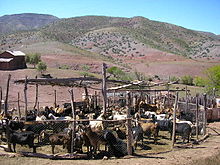



Overgrazing occurs when plants are exposed to intensive grazing for extended periods of time, or without sufficient recovery periods.[1] It can be caused by either livestock in poorly managed agricultural applications, game reserves, or nature reserves. It can also be caused by immobile, travel restricted populations of native or non-native wild animals.
Overgrazing reduces the usefulness, productivity and biodiversity of the land and is one cause of desertification and erosion. Overgrazing is also seen as a cause of the spread of invasive species of non-native plants and of weeds. Degrading land, emissions from animal agriculture and reducing the biomass in a ecosystem contribute directly to climate change[2] between grazing events. Successful planned grazing strategies have been in support of the American bison of the Great Plains,[3][4] or migratory wildebeest of the African savannas,[5] or by holistic planned grazing.[6]
- ^ Mysterud, Atle (2006). "The concept of overgrazing and its role in management of large herbivores". Wildlife Biology. 12 (2): 129–141. doi:10.2981/0909-6396(2006)12[129:TCOOAI]2.0.CO;2. ISSN 0909-6396. S2CID 55599448.
- ^ "The relationship between overgrazing and the US environment". ArcGIS StoryMaps. 13 March 2020. Retrieved 2021-03-20.
- ^ Laduke, Winona (1999). All Our Relations: Native Struggles for Land and Life. Cambridge, MA: South End Press. p. 146. ISBN 0896085996. Retrieved 30 March 2015.
- ^ Duval, Clay. "Bison Conservation: Saving an Ecologically and Culturally Keystone Species" (PDF). Duke University. Archived from the original (PDF) on March 8, 2012. Retrieved April 13, 2015.
- ^ In balance with, and accompanied by, prides of keystone predators.
- ^ "Holistic Land Management: Key to Global Stability" by Terry Waghorn. Forbes. 20 December 2012.